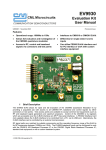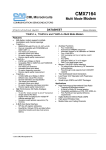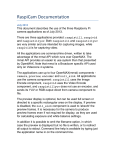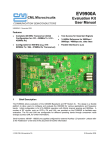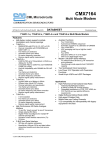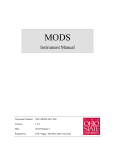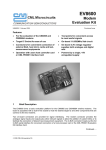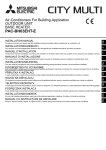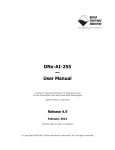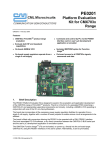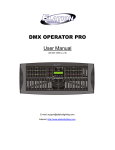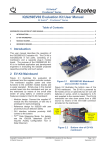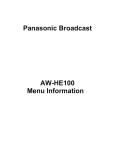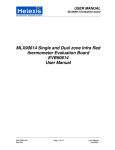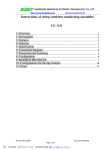Download Evaluation Kit for CMX998 IC
Transcript
CML Microcircuits COMMUNICATION SEMICONDUCTORS UM9980/2 August 2006 EV9980 Evaluation Kit User Manual Provisional Issue Features • Allows full evaluation and investigation of the CMX998 Cartesian Feedback Transmitter IC • Support and interfacing for customer PAs • Operational range: 100MHz to 1GHz by use of on-board matching components • Interfaces to CMX981 EvKit • Access to RF, control and baseband signals via connectors and test points • Differential or single-ended I and Q inputs • Complete demonstration of the CFBL functionality: default is 400MHz and configurable for 800MHz • Can utilise PE0001 EvKit interface card for PC interface or work with custom interface equipment 1. Brief Description The EV9980 EvKit allows rapid and full evaluation of the CMX998 Cartesian Feedback Transmitter IC. In the form of a populated PCB, this flexible platform enables users, using a control interface, to configure and evaluate the CMX998 to various applications and frequency bands. Access is provided to all CMX998 RF, baseband and control signals by either connector or test points. Test access points are available to accept common test equipments such as RF and baseband signal generators and spectrum analysers. All signal paths are matched by suitable components and the EvKit provides, on-board, two power amplifier devices, one at 400MHz (default) and one at 800MHz; support is also available for the connection and operation of a custom PA. The overall operating evaluation frequency range of the EvKit is for RF frequencies between 100MHz and 1GHz. The EV9980 can be configured to work with the CMX981 Digital Radio Baseband processor IC or with a custom baseband system. No software is required for use of the EvKit; the on-board CMX998 is controlled via its C-BUS serial interface and control system. An evaluation interface is supplied separately that uses the CML PE0001 EvKit Interface Card and is controlled via the EV9980 PC software. Also a custom C-BUS interface and control system can be used. © 2006 CML Microsystems Plc Evaluation Kit for CMX998 EV9980 CONTENTS Section Page 1. Brief Description ..................................................................................... 1 2. Preliminary Information.......................................................................... 5 2.1. Laboratory Equipment.................................................................. 5 2.1.1. Power Supply.................................................................. 5 2.2. Handling Precautions................................................................... 5 2.2.1. Static Protection.............................................................. 5 2.2.2. Contents - Unpacking ..................................................... 5 2.3. Approvals ..................................................................................... 5 3. Quick Start ............................................................................................... 6 3.1. Setting-Up .................................................................................... 6 3.2. Input Conditions ........................................................................... 6 3.3. Operation ..................................................................................... 7 4. Signal Lists .............................................................................................. 8 5. Circuit Schematics and Board Layouts.............................................. 12 6. Detailed Description ............................................................................. 14 6.1. Hardware Description ................................................................ 14 6.1.1. Cartesian Feedback Loop (CFBL) ................................ 14 6.1.2. Power Amplifiers ........................................................... 14 6.1.3. Local Oscillator (LO) ..................................................... 14 6.1.4. IQ Baseband Inputs ...................................................... 15 6.1.5. CMX981 Interface ......................................................... 15 6.1.6. Manual DC Nulling ........................................................ 15 6.1.7. Power Supply................................................................ 15 6.2. Adjustments and Controls.......................................................... 15 6.2.1. 800MHz Operation........................................................ 15 6.3. Software Description.................................................................. 16 6.3.1. The CMX998 ($01-$06) Tab......................................... 16 6.3.2. The CMX998 ($07-$08, $F2-$F8) Tab ......................... 17 6.3.3. The Script Handler Tab................................................. 18 6.4. Application Information .............................................................. 19 6.4.1. Error Configuration........................................................ 19 6.4.2. Typical Performance of Closed Loop Configuration ..... 20 6.4.3. Testing the CMX998 with the CMX981......................... 25 6.5. Troubleshooting ......................................................................... 29 6.5.1. Closed Loop Operation ................................................. 29 6.5.2. Open Loop Operation ................................................... 30 7. Performance Specification................................................................... 31 7.1. Electrical Performance............................................................... 31 7.1.1. Absolute Maximum Ratings .......................................... 31 7.1.2. Operating Limits............................................................ 31 7.1.3. Operating Characteristics ............................................. 32 © 2006 CML Microsystems Plc 2 UM9980/2 Evaluation Kit for CMX998 EV9980 Table Page Table 1 – Signal List......................................................................................................................... 9 Table 2 – PE0001 Interface ............................................................................................................. 9 Table 3 – Test Loops ..................................................................................................................... 10 Table 4 – Test Points ..................................................................................................................... 11 Table 5 – EV9980 and EV9810 interconnection details ................................................................ 25 Table 6 – Closed Loop possible errors .......................................................................................... 29 Table 7 – Open Loop possible errors ............................................................................................ 30 Page Figure Figure 1 – Block Diagram ................................................................................................................ 4 Figure 2 – Typical Evaluation Connections for EV9980 .................................................................. 6 Figure 3 – PCB Layout: top............................................................................................................ 12 Figure 4 – PCB Layout: bottom...................................................................................................... 13 Figure 5 – The CMX998 ($01-$06) Tab......................................................................................... 16 Figure 6 – The CMX998 ($07-$08, $F2-$F8) Tab ......................................................................... 17 Figure 7 – The Script Handler Tab ................................................................................................ 18 Figure 8 – Error Amplifier Configuration ........................................................................................ 19 Figure 9 – CMX998 and RF2175 performance closed loop (left) and open loop (right) at approximately the same PEP output level, 400MHz...................................................................... 20 Figure 10 – CMX998 and RF2175 performance closed loop (lower) and open loop (upper) same PEP output level with 18ksymbols/s π/4DQPSK modulation, 400MHz ......................................... 20 Figure 11 – CMX998 and RF2175 performance closed loop with 18ksymbols/s π/4DQPSK modulation, 400MHz ...................................................................................................................... 21 Figure 12 – Broadband (1MHz)plot of CMX998 and RF2175 performance closed loop with 18ksymbols/s π/4DQPSK modulation, 400MHz ............................................................................ 22 Figure 13 – CMX998 and RF2173 performance closed loop (left) and open loop (right) at approximately the same PEP output level, 800MHz...................................................................... 22 Figure 14 – CMX998 and RF2173 performance closed loop 18dB feedback path attenuation.... 23 Figure 15 – CMX998 and RF2173 performance closed loop with phase control at extremes of stability = 11.25deg. (left) and 135deg. (right) showing classic peaking of noise when feedback phase is incorrect. .......................................................................................................................... 23 Figure 16 – CMX998 and RF2173 performance correctly adjusted closed loop with phase control of 67.50 deg. resulting in a clean spectrum ................................................................................... 24 Figure 17 – CMX998 Input Amplifier Configuration ....................................................................... 25 Figure 18 – CMX998 Configuration for testing with CMX981........................................................ 26 Figure 19 – 1st and 2nd ACP Performance ..................................................................................... 26 Figure 20 – Open and closed loop performance comparison ....................................................... 27 Figure 21 – Trellis Diagram............................................................................................................ 27 Figure 22 – Constellation Diagram ................................................................................................ 28 Figure 23 – Symbol/Error Table..................................................................................................... 28 It is always recommended that you check for the latest product datasheet version from the Datasheets page of the CML website: [www.cmlmicro.com]. © 2006 CML Microsystems Plc 3 UM9980/2 Evaluation Kit for CMX998 EV9980 LP Filter External IQ Inputs CMX981 Interface Attenuator Differential I/Q DCMEAS Instability Detector PA Ramp TX-OUT 800MHz RFOUT RFIN CMX998 CFBL IC PA RF2173 Coupler TX-OUT 400MHz PA KEY C-BUS Interface RF2175 Coupler Interface Connector LO-IN Coax Connector Figure 1 – Block Diagram © 2006 CML Microsystems Plc 4 UM9980/2 Evaluation Kit for CMX998 2. EV9980 Preliminary Information The EV9980 provides a platform for the evaluation of the CMX998. To use the EV9980, a separate micro-controller or PC, for example, is required to program the CMX998 via its C-BUS interface. This controlling device is not included on the EV9980 but there is a CML product available to provide the controlling functionality: the PE0001 with EV9980 PC software (ES9980xx.exe). 2.1. Laboratory Equipment The following laboratory equipment is needed to use this evaluation kit: • • • • • Dual Power Supply Spectrum Analyzer (100MHz to 1GHz) RF Attenuator RF Signal Generator (100MHz to 2GHz) I/Q Signal Source For more detailed design or investigation work the customer may require other RF test equipment. 2.1.1. Power Supply The supply input voltage to the PCB, for all circuits except the PA, is 7.2V (5.25V to 8V acceptable). On board regulators are provided to generate all voltage rails used on the PCB (3.3V and 5V rails are used). The supply to the PA is directly connected to the PA: a voltage of 3.6V, at the PA, is recommended. (See also section 6.5.1) The 7.2V supply should be rated at 1A and the 3.6V supply rated at 2A. NOTE: Care should be exercised with the supplies, as they are not protected for reverse polarity. For optimum RF performance, the PA supply is connected directly to the RF2173 and RF2175 device so care is required to ensure the RF2173 and RF2175 manufacturer's ratings are not exceeded. 2.2. Handling Precautions Like most evaluation kits, this product is designed for use in office and laboratory environments. The following practices will help ensure its proper operation. 2.2.1. Static Protection This product uses low power CMOS circuits that can be damaged by electrostatic discharge. Partially damaged circuits can function erroneously, leading to misleading results. Observe ESD precautions at all times when handling this product. 2.2.2. Contents - Unpacking Please ensure that you have received all of the items on the separate information sheet (EK9980) and notify CML within 7 working days if the delivery is incomplete. 2.3. Approvals This product is not approved to any EMC or other regulatory standard. Users are advised to observe local statutory requirements, which may apply to this product and the radio frequency signals that may emanate from it. © 2006 CML Microsystems Plc 5 UM9980/2 Evaluation Kit for CMX998 3. EV9980 Quick Start This section provides instructions for users who wish to experiment immediately with the evaluation kit. A more complete description of the kit and its use appears later in this document. The EV9980 includes a CMX998 device that is described in its own, separate, datasheet. Accordingly, the user should read the current CMX998 datasheet before using the EV9980. 3.1. Setting-Up The following procedure is recommended: 1. Connect test leads as shown below in Figure 2. 2. Connect a host µController to C-BUS interface J13 or J15 (alternatively the CML PE0001 card and ES9980xx.exe software can be used – see section 6.3). 3. The power amplifier output (J9) should be connected to a suitable 50Ω load. The default frequency of operation for the EV9980 is 400MHz. The use of an external 50Ω Load is essential to prevent possible damage to the PA stage. 4. Power should be applied to the main supply (7.2V nominal). 5. A connection should be made to J12 pin 15 to allow the PA control volts to be adjusted 6. Power should be applied to the power amplifier supply connector (3.6V). The board is now ready for operation. - - J3 J2 J13 J15 J11 Baseband IQ Generator J7 Pin15 PA Control Voltage - CMX998 J4 - J8 - J9 - J12 J5 J6 J1 - - - J10 30dB RF Attenuator RF Spectrum Analyzer +7.2V GND Power Amp +3.6V RF Signal Generator Figure 2 – Typical Evaluation Connections for EV9980 3.2. Input Conditions LO Input (J1) should be at 800MHz at –10dBm. No baseband I and Q signals (J5 and J3) should be applied at this time only a 0VDC bias input is required. For reference: the nominal I and Q input is an AC input signal level of ~500mVp-p at 0VDC bias. © 2006 CML Microsystems Plc 6 UM9980/2 Evaluation Kit for CMX998 3.3. EV9980 Operation It is recommended that the user familiarise themselves with the IC datasheet and the EV9980 user manual prior to attempting to use the EV9980. To use the EV9980 the user will need a mechanism to control the CMX998 via its C-BUS interface, which is brought out on connector J13 (J15 can also be used) on the EV9980. The CMX998 datasheet gives details of the registers and commands. To operate the CMX998, a typical general register setup is given below: • • • • • • • • • Initially no IQ signals should be applied. The general control register should be configured such that the bias circuits, filter amplifiers, input amplifiers, error amplifiers, forward path and feedback path are all enabled. Bits 0 and 1 of the general control register should be in their normal operation state i.e. b0/b1 = 0. A typical setting for the phase control register would be 22.5degs. Typical setting for the forward and feedback path attenuator would be 0dB and 13dB respectively (this configuration gives full output power at 400MHz). The frequency control register should be set for divide by 2 mode (this means that a LO input has to be applied at twice the operating frequency). To achieve the nominal output power from the PA a control voltage of 1.1VDC needs to be applied to pin 15 of J12. The output should be analysed to ensure loop phase is set correctly. The level of the carrier signal needs to be adjusted for a minimum by use of VR1 and VR2. Baseband IQ signals can now be applied to achieve the nominal output power level of ~+29dBm (average power). © 2006 CML Microsystems Plc 7 UM9980/2 Evaluation Kit for CMX998 4. EV9980 Signal Lists CONNECTOR PINOUT Connector Ref. Connector Pin No. Signal Name Signal Type J1 N/A LO-IN RF LO input can be applied at 2 x RF output frequency or 4 x RF output frequency. Nominal input level is -10dBm. J2 N/A TXQ+ Baseband Q input signal (non-inverting input of input amplifier) J3 N/A TXQ- Baseband Q input signal (inverting input of input amplifier) J4 N/A RFIN RF RF input to feedback path J5 N/A TXI- Baseband I input signal (inverting input of input amplifier) J6 N/A TXI+ Baseband I input signal (non-inverting input of input amplifier) J7 N/A RFOUT RF Upconverter RF output J8 N/A TX-OUT 800MHz RF 800MHz PA output J9 N/A TX-OUT 400MHz RF 400MHz PA output J10 3 +7.2V DC 7.2V power supply input J10 2 +3.6V DC 3.6V power supply for RF power amplifier J10 1 GND DC Power supply ground J11 1, 3, 7, 9 TXQ+, TXQTXI-, TXI+ Baseband Differential I/Q input from the CMX981 evaluation board J11 2, 4, 5, 6, 8, 10 GNDA Baseband Connection to Analogue Ground J12 1 INSTAB Baseband Instability detector output to CMX981 connector J12 3 DCMEAS Baseband DCMEAS output to CMX981 connector J12 5 FW_Q Baseband Forward path baseband Q signal to CMX981 connector J12 7 FB_Q Baseband Feedback path baseband Q signal to CMX981 connector J12 9 FB_I Baseband Feedback path baseband I signal to CMX981 connector J12 11 FW_I Baseband Forward path baseband I signal to CMX981 connector J12 15 PA_CNTRL DC PA control voltage external or from CMX981 evaluation board © 2006 CML Microsystems Plc 8 Description UM9980/2 Evaluation Kit for CMX998 EV9980 CONNECTOR PINOUT Connector Ref. Connector Pin No. Signal Name Signal Type J13 1 - 20 C-BUS Interface Logic C-BUS interface from PE0001 or host / controller PC. See schematics and CMX998 datasheet for details. J15 1 - 10 Alternative C-BUS Interface Logic Alternative header for C-BUS interface Description Table 1 – Signal List CONNECTOR PINOUT for J13 Connector Pin No. Signal Name Signal Type Description 1 RESET I/P General RESET (RESET active low) 2 CSN I/P C-BUS Enable 3 ~ ~ Spare pin. Leave unconnected. 4 S_DATA_IN I/P C-BUS Data Input 5 ~ ~ Spare pin. Leave unconnected. 6 S_CLOCK I/P C-BUS Clock 7 ~ ~ Spare pin. Leave unconnected. 8 S_DATA_OUT O/P C-BUS Data Output 9 ~ ~ Spare pin. Leave unconnected. 10 IRQN I/P Interrupt request - if required. Not used. 11 GNDD Power Connection to Digital Ground 12 GNDD Power Connection to Digital Ground 13 ~ ~ Spare pin. Leave unconnected. 14 ~ ~ Spare pin. Leave unconnected. 15 ~ ~ Spare pin. Leave unconnected. 16 ~ ~ Spare pin. Leave unconnected. 17 ~ ~ Spare pin. Leave unconnected. 18 ~ ~ Spare pin. Leave unconnected. 19 ~ ~ Spare pin. Leave unconnected. 20 ~ ~ Spare pin. Leave unconnected. Table 2 – PE0001 Interface © 2006 CML Microsystems Plc 9 UM9980/2 Evaluation Kit for CMX998 EV9980 TEST LOOPS Test Loop Ref. Default Measurement Description TL1 Q Input Amplifier Output TL2 Instability Detector Output TL3 Q Image Filter Amplifier Output TL4 Q Error Amplifier Output TL5 1.6VDC BVREF Buffered Vref TL6 I Error Amplifier Output TL7 I Image Filter Amplifier Output TL8 Demodulator Output (Q channel) TL9 Demodulator Output (I channel) TL10 I Input Amplifier Output TL11 Connection point for AVdd on CMX981 evaluation board TL12 800MHz power amplifier control voltage TL13 400MHz power amplifier control voltage TL14 DCMEAS Output TL15 Spare connection on J12:J13 TL16 C-BUS Data Output TL17 IRQN (not used) TL18 GND probe point TL19 GND probe point Table 3 – Test Loops © 2006 CML Microsystems Plc 10 UM9980/2 Evaluation Kit for CMX998 EV9980 TEST POINTS Test Point Ref. Default Measuremen t TP1 3.3V 3.3V regulator output for digital circuits TP2 3.3V 3.3V regulator output for analogue circuits TP3 5.0V 5.0V regulator output for RF circuits TP7 0V Digital Ground TP8 0V Digital Ground TP9 0V Analogue Ground TP10 0V Analogue Ground Description Table 4 – Test Points Notes: I/P O/P BI TL TP = = = = = © 2006 CML Microsystems Plc Input Output Bidirectional Test Loop Test Point 11 UM9980/2 Evaluation Kit for CMX998 5. EV9980 Circuit Schematics and Board Layouts For clarity, circuit schematics are available as separate high-resolution files. These can be obtained via the CML website. The following changes apply to the EV9980 PCB (PCB555B) Mod. State 2, when referring to schematic (DWG9980B04.pdf). These changes have already been made to the Evaluation Kit. No 1 Circuit Area and Component Reference +V power line C109, C133, J10 Comment Change Cure coupling between 400MHz PA and power supply which caused degraded adjacent channel power. Cut +V track on the top layer of the board close to C109 Place a wire link on bottom layer between J10 pin 3 and C133 The layout on each side of the pcb is shown in Figure 3 and Figure 4, below: Figure 3 – PCB Layout: top © 2006 CML Microsystems Plc 12 UM9980/2 Evaluation Kit for CMX998 EV9980 Figure 4 – PCB Layout: bottom © 2006 CML Microsystems Plc 13 UM9980/2 Evaluation Kit for CMX998 6. EV9980 Detailed Description The CMX998 datasheet (not included, but available at www.cmlmicro.com) should be referred to for a detailed description of the CMX998 device. The EV9980 functionality includes: • • • • • Demonstration of the CFBL RF functionality, PA devices have been included to allow operation at 400MHz and 800MHz to be evaluated in detail. Operation at 100MHz to 1000MHz. Support for customer power amplifiers at different powers and frequencies over the full operating range of the CFBL IC. C-BUS Interface that allows the card to be connected to a host µController. Interface to a PC for initial test and customer evaluation is available separately with suitable PC software that allows control of all device functions. Interface directly to CMX981 evaluation card allows demonstration of: o o π/4-DQPSK modulation burst and continuous transmission In summary, the EV9980 allows the user to create experiments to investigate all aspects of the CMX998 device. The EV9980 is designed to allow user modification, to support detailed investigation of each user’s specific and different applications. 6.1. Hardware Description 6.1.1. Cartesian Feedback Loop (CFBL) The card is configured to allow the CFBL to operate in normal operation with single ended external inputs. The gains are set in the baseband amplifier sections to suit the input drive levels in section 6.1.4. The error amplifier is configured with a loop filter optimised for operation with the on-board power amplifiers but can be configured with user values for any other requirements. It is possible to access the up-converter output and the down-converter input so that customers can connect their own power amplifiers into the loop. The LO input, up-converter output and the down-converter input are all matched with broadband balun/transformer to allow wideband operation from 100MHz to 1GHz. The RESET pin (active low) is pulled high with 100k ohms. The user can pull this pin low to reset the device (or the software reset can be used). 6.1.2. Power Amplifiers The card includes power amplifiers to demonstrate the CFBL IC at ~400MHz or ~800MHz. The 400MHz amplifier (default connection) is capable of producing 29~30dBm (mean) with pulsed π/4DQPSK modulation. An option of using a 800MHz power amplifier is included in the design and this is also capable of 30dBm (mean) output with π/4-DQPSK modulation. Component changes are required to make use of this option, see section 6.2.1. Gain control has been included which allows the power amplifiers to be connected to the CMX981 Ramping DAC or to an external variable voltage source. 6.1.3. Local Oscillator (LO) The local oscillator has not been provided on the EV9980. A connector is provided to allow an external oscillator source to be injected at twice or four times the RF output frequency depending on the oscillator mode selected. © 2006 CML Microsystems Plc 14 UM9980/2 Evaluation Kit for CMX998 6.1.4. EV9980 IQ Baseband Inputs The board allows the IQ inputs to come from the CMX981 or from an alternative external source. The input can be differential or single ended. Adjusting the values around the CMX998 input amplifiers creates the required input configuration. The default setup is for single ended inputs, which are applied to TXI- and TXQ-. A typical input signal would be ~500mVp-p at 0VDC bias. 6.1.5. CMX981 Interface The EV9980 has an interface to allow connection to the CMX981 Evaluation card. There are two connectors J11 and J12 that include the following signals: • • • • • 6.1.6. I/Q Input signals from CMX981 DCMEAS pin from CMX998 to CMX981 AUX ADC Ramping DAC signal from CMX981 to EV9980 power amplifiers Instability detector output DC Nulling signal input (optional) Manual DC Nulling The DC nulling can be done manually through the use of VR1 and VR2 variable resistors. They affect the DC level of at the input to the modulator so that the carrier can be nulled to a minimum manually. Automatic control has been implemented through the CMX981 interface. 6.1.7. Power Supply The input to the PCB for CMX998 and interface circuits is nominally 7.2V (5.25V to 8V is acceptable). On board regulators are provided to generate voltage rails used on the EV9980 (3.3V used for CFBL IC). The power supply to the PA is directly from a separate 3.6V input. 6.2. Adjustments and Controls The user has the ability to configure the EV9980 for a number of different operational scenarios. 6.2.1. 800MHz Operation The default operating frequency is 400MHz, so the following components need to be changed to enable the EV9980 to work at 800MHz: • • • • • C98, C99, R86 become not fitted (NF) C76, C78 should be 1nF R74 should be 0R L10 should be 0R C121, C122 should be not fitted (NF) Typical values for CMX998 registers at 800MHz are: • • • phase control register 67.50 degrees forward path attenuation = 0dB feedback path attenuation = 18dB (Note: for 400MHz typical values see section 3.3) © 2006 CML Microsystems Plc 15 UM9980/2 Evaluation Kit for CMX998 6.3. EV9980 Software Description The EV9980 does not require any embedded firmware. The CML product PE0001, available separately, can be used with the EV9980 and the related PC software (ES9980xx.exe). The ES9980 application allows the user to interact with the EV9980 via an easy to use graphical interface. It consists of three tabs: each one representing a particular set of registers or a particular function of the CMX998. To select a tab simply click on the corresponding name in the row at the top of the program window. Setting or clearing the check box associated with a bit of a register will cause that bit to be set or cleared when the register is next written to. If the ‘Auto Write’ check box is set a register will be written whenever a check box or list box associated with it is modified. This removes the need to click the ‘Write’ button associated with that register. The program can be closed at any time by clicking the ‘Close’ button or by pressing ‘Alt’ and ‘C’ keys simultaneously. 6.3.1. The CMX998 ($01-$06) Tab The CMX998 ($01-$06) tab gives access to the general control register, gain control register, phase control register and general reset command, see Figure 5. In the case of the gain and phase control register slide bars have been used to allow easy control during operation. Figure 5 – The CMX998 ($01-$06) Tab © 2006 CML Microsystems Plc 16 UM9980/2 Evaluation Kit for CMX998 6.3.2. EV9980 The CMX998 ($07-$08, $F2-$F8) Tab The CMX998 ($07-$08, $F2-$F8) tab gives access to the aux control and frequency control registers, see Figure 6. This tab also allows the registers $F2 to $F8 to be read individually. Figure 6 – The CMX998 ($07-$08, $F2-$F8) Tab © 2006 CML Microsystems Plc 17 UM9980/2 Evaluation Kit for CMX998 6.3.3. EV9980 The Script Handler Tab The Script Handler tab allows the execution of script files consisting of register write and read, delay commands, see Figure 7. Figure 7 – The Script Handler Tab The script files should be ASCII text files with each line containing one of following commands: • • • • • • Register write (8 bit) – Register read (8 bit) – Register write (16 bit) – Register read (16 bit) – Delay Comment line - WR8_AA_DD RD8_AA W16_AA_DDDD R16_AA DELAY_X..X //C..C Where AA is the 2 digit register address in hexadecimal, _ is a single space character, DD is the 2 digit register value in hexadecimal, X..X is a time to delay by in 10ms units and C..C is an ASCII string. The delay command stops any following script commands from being executed until the delay period has passed. © 2006 CML Microsystems Plc 18 UM9980/2 Evaluation Kit for CMX998 EV9980 Each line must contain only one command and no other characters. An example script file is: // Example Script File for EV9980 // // WR8 01 00 // send RESET // WR8 02 3F //ENABLE VBIAS, Filter Pwr, Input Amp Pwr, Error Amp PWR, Open Loop Mode, Error Amp Gain reduction // RD8 F2 // Read General Control Register // w16 04 0012 R16 F4 // Set Forward gain=0dB, Feedback gain=-20dB; Read back Gain Control Register The results window will display the value returned by register read commands. These results can be saved to an ASCII text file or discarded by clicking on the ‘Save Results’ or ‘Clear Results’ buttons, respectively. The ES9980 application will update the displayed register values to reflect those of any register read or write commands contained in an executed script file. When script file is being executed the other tabs cannot be selected. A script file can be executed once, repeatedly until the ‘Stop’ button is pressed or a specified number of times. The execution of a script file can be stopped or paused at any time by clicking the appropriate button. 6.4. Application Information 6.4.1. Error Configuration The error amplifier configuration used on the EV9980 is shown in Figure 8. The following conditions apply to the values fitted on the EV9980, the 1st Pole is at ~16kHz, the 2nd Pole is at ~32kHz and the Zero is at ~320kHz. These can be changed for any user requirement. C21/ C41 R18/R38 FW_I/Q R25/R32 R20/R36 MODIP/ MODQP Error Amp FB_I/Q C26/ C36 R21/R37 R24/ R40 C24/C37 Figure 8 – Error Amplifier Configuration © 2006 CML Microsystems Plc 19 UM9980/2 Evaluation Kit for CMX998 6.4.2. EV9980 Typical Performance of Closed Loop Configuration The following plots show typical performance of the EV9980 with two-tone and 18ksymbols/s π/4DQPSK modulation. Delta 3 [T1] Ref Lvl -63.23 dB 44 dBm RBW 500 Hz VBW 500 Hz SWT -32.06412826 kHz RF Att 40 dB Delta 3 [T1] Ref Lvl 2 s Unit dBm 44 RBW 500 Hz VBW 500 Hz SWT -32.06412826 kHz RF Att 2 s 40 dB Unit dBm 44 30.5 dB Offset 40 -27.70 dB 44 dBm 1 [T1] 26.17 dBm A 30.5 dB Offset 40 1 [T1] 400.00911824 MHz 3 [T1] 30 1 3 [T1] -32.06412826 kHz 1 1 [T1] 20 -32.37 dB -9.01803607 kHz -62.15 dB 16.03206413 kHz 10 1VIEW -27.70 dB 30 -39.97 dB -9.01803607 kHz 2 [T1] A 400.00911824 MHz -63.23 dB -32.06412826 kHz 1 [T1] 20 25.59 dBm 2 [T1] 1SA 16.03206413 kHz 10 1VIEW 0 0 -10 -10 -29.48 dB 3 1SA 2 1 1 -20 -20 -30 -30 2 3 -40 -40 -50 -50 -56 -56 Center 400 MHz Date: 10 kHz/ 10.MAR.2006 Span 100 kHz Center 400 MHz 09:30:22 Date: 10 kHz/ 10.MAR.2006 Span 100 kHz 09:30:53 Figure 9 – CMX998 and RF2175 performance closed loop (left) and open loop (right) at approximately the same PEP output level, 400MHz RBW 500 Hz Ref Lvl VBW 500 Hz 35 dBm SWT 2 s RF Att Unit 30 dB dBm 35 30.5 dB Offset A 30 20 10 1VIEW 2VIEW 0 1SA 2SA -10 -20 -30 -40 -50 -60 -65 Center 400 MHz Date: 10.MAR.2006 10 kHz/ Span 100 kHz 09:38:51 Figure 10 – CMX998 and RF2175 performance closed loop (lower) and open loop (upper) same PEP output level with 18ksymbols/s π/4DQPSK modulation, 400MHz © 2006 CML Microsystems Plc 20 UM9980/2 Evaluation Kit for CMX998 EV9980 Marker 1 [T1] RBW 500 Hz Ref Lvl 19.44 dBm VBW 500 Hz 35 dBm 400.00330661 MHz SWT 2 s RF Att Unit 30 dB dBm 35 30.5 dB Offset 1 [T1] 19.44 dBm 30 A 400.00330661 MHz CH PWR 1 20 28.73 dBm ACP Up -66.60 dB ACP Low -64.87 dB 1 [T1] 0.00 dB 10 0.00000000 Hz 1VIEW 0 1SA -10 -20 -30 -40 C0 C0 -50 cl1 cl1 cu1 -60 cu1 -65 Center 400 MHz Date: 10.MAR.2006 10 kHz/ Span 100 kHz 09:35:15 Figure 11 – CMX998 and RF2175 performance closed loop with 18ksymbols/s π/4DQPSK modulation, 400MHz © 2006 CML Microsystems Plc 21 UM9980/2 Evaluation Kit for CMX998 EV9980 RBW 5 kHz Ref Lvl VBW 5 kHz 35 dBm SWT RF Att 100 ms 30 dB Unit dBm 35 30.5 dB Offset A 30 20 10 0 2VIEW 2SA -10 -20 -30 -40 -50 -60 -65 Center 400 MHz Date: 100 kHz/ 10.MAR.2006 Span 1 MHz 09:40:39 Figure 12 – Broadband (1MHz)plot of CMX998 and RF2175 performance closed loop with 18ksymbols/s π/4DQPSK modulation, 400MHz Marker 1 [T1] RBW 500 Hz Ref Lvl 27.84 dBm VBW 500 Hz 35 dBm 799.99328657 MHz SWT 2 s RF Att Unit RBW 500 Hz Ref Lvl 27.44 dBm VBW 500 Hz 35 dBm 799.99328657 MHz SWT Marker 1 [T1] 30 dB dBm 2 s RF Att Unit 30 dB dBm 35 35 30.5 dB Offset 1 [T1] 1 30 30.5 dB Offset 27.84 dBm 30 A 1 [T1] 1 799.99328657 MHz 1 [T1] 2 [T1] 1 [T1] 20 2 [T1] -55.87 dB 3 [T1] -16.03206413 kHz 4 [T1] 0 0 1 -32.06412826 kHz 1 -10 -27.61 dB -16.03206413 kHz 3 -58.31 dB 1SA -31.24 dB 7.01402806 kHz 10 3 [T1] -32.20 dB -2.00400802 kHz -40.64 dB 7.01402806 kHz 10 A 799.99328657 MHz -39.49 dB -2.00400802 kHz 20 27.44 dBm 2 4 [T1] -37.45 dB 1SA -32.06412826 kHz 4 -10 2 -20 -20 3 4 -30 -30 -40 -40 -50 -50 -60 -60 -65 -65 Center 800 MHz Date: 10.MAR.2006 10 kHz/ 15:06:24 Center 800 MHz Span 100 kHz Date: 10.MAR.2006 10 kHz/ Span 100 kHz 15:08:04 Figure 13 – CMX998 and RF2173 performance closed loop (left) and open loop (right) at approximately the same PEP output level, 800MHz © 2006 CML Microsystems Plc 22 UM9980/2 Evaluation Kit for CMX998 EV9980 RBW 500 Hz Ref Lvl 26.45 dBm VBW 500 Hz 35 dBm 799.99328657 MHz SWT Marker 1 [T1] RF Att 2 s 30 dB Unit dBm 35 30.5 dB Offset 1 [T1] 30 1 26.45 dBm A 799.99328657 MHz 1 [T1] -39.63 dB 20 -2.00400802 kHz 2 [T1] -45.63 dB 7.01402806 kHz 10 3 [T1] -65.19 dB -16.03206413 kHz 0 4 [T1] -66.88 dB 1SA -32.06412826 kHz -10 1 2 -20 -30 3 4 -40 -50 -60 -65 Center 800 MHz Date: 10 kHz/ 10.MAR.2006 Span 100 kHz 15:07:21 Figure 14 – CMX998 and RF2173 performance closed loop 18dB feedback path attenuation RBW 5 kHz Ref Lvl VBW 5 kHz 35 dBm SWT 100 ms RF Att Unit RBW 5 kHz Ref Lvl VBW 5 kHz 35 dBm SWT 30 dB dBm 100 ms RF Att Unit 30 dB dBm 35 35 30.5 dB Offset 30.5 dB Offset A 30 A 30 20 20 10 10 0 0 2SA 2SA -10 -10 -20 -20 -30 -30 -40 -40 -50 -50 -60 -60 -65 -65 Center 800 MHz Date: 10.MAR.2006 100 kHz/ 15:11:11 Center 800 MHz Span 1 MHz Date: 10.MAR.2006 100 kHz/ Span 1 MHz 15:10:46 Figure 15 – CMX998 and RF2173 performance closed loop with phase control at extremes of stability = 11.25deg. (left) and 135deg. (right) showing classic peaking of noise when feedback phase is incorrect. © 2006 CML Microsystems Plc 23 UM9980/2 Evaluation Kit for CMX998 EV9980 RBW 5 kHz Ref Lvl VBW 5 kHz 35 dBm SWT 100 ms RF Att Unit 30 dB dBm 35 30.5 dB Offset A 30 20 10 0 2SA -10 -20 -30 -40 -50 -60 -65 Center 800 MHz Date: 10.MAR.2006 100 kHz/ Span 1 MHz 15:10:17 Figure 16 – CMX998 and RF2173 performance correctly adjusted closed loop with phase control of 67.50 deg. resulting in a clean spectrum © 2006 CML Microsystems Plc 24 UM9980/2 Evaluation Kit for CMX998 6.4.3. EV9980 Testing the CMX998 with the CMX981 The EV9980 has an IQ interface to the EV9810 through the use of a 10-way header. The connections should be made, as follows: EV9980 (J11) Label Pin No 981_Q+ 1 981_Q3 GNDA 5 981_I7 981_I+ 9 EV9810 (J9) Label Pin No QTXP 10 QTXN 8 GNDANALOG 6 ITXN 4 ITXP 2 Table 5 – EV9980 and EV9810 interconnection details (Note: See also Figure 18). The TX output of the CMX981 is differential I and Q, with a single ended signal level of 1Vp-p @1.28VDC. The CMX998 input amplifiers need to convert this differential signal into a single ended 1Vp-p @1.6VDC signal. A typical configuration for the input amplifiers on the 998 is shown in Figure 17. +3.3V 620k 100k 1Vp-p @1.28VDC 1Vp-p @1.28VDC Input Amp 100k 1Vp-p @1.6VDC 10k Figure 17 – CMX998 Input Amplifier Configuration The results shown in this section were taken with the CMX998 configured as Figure 18. The component changes to the EV9980 to allow this configuration to work are: Move C55 to C54 Move C27 to C30 Make C35 a 0R (0603 resistor) To get ~0dBm after the splitter (splitter loss assumed to be ~3dB) the attenuator in the forward path = 0dB, the attenuator in the feedback path ~23-24dB. The optimal phase setting will vary between setups as it is determined by the length of leads used to complete the RF loop. On a 1MHz span on the spectrum analyser, check for noise humping to ensure correct phase has been set. The plots in Figure 19, Figure 20, Figure 21, Figure 22 and Figure 23 show the ACP performance, an open and closed loop comparison, trellis diagram, constellation diagram and symbol/error table respectively. © 2006 CML Microsystems Plc 25 UM9980/2 Evaluation Kit for CMX998 EV9980 EV9980 1 - - J3 J2 J13 J9 J15 EV9810 J11 1 Splitter CMX998 J7 J4 - J8 - J9 - J12 J5 J6 J1 - - - RF Spectrum Analyzer- J10 +7.2V GND Do Not Connect a supply to +V_PA RF Signal Generator Figure 18 – CMX998 Configuration for testing with CMX981 Marker 1 [T1] -19.84 dBm Ref Lvl 389.99780261 MHz 0 dBm RBW 500 Hz VBW 2 kHz SWT RF Att 2.4 s 0 30 dB Unit 1 [T1] dBm -19.84 dBm 389.99780261 MHz CH PWR -10 A 0.14 dBm ACP Up -69.05 dB ACP Low -70.33 dB 1 -20 ALT1 Up -74.52 dB ALT1 Low -73.71 dB -30 1SA -40 -50 -60 cl2 -70 cl2 cu2 cu2 -80 C0 C0 cl1 cl1 -90 cu1 cu1 -100 Center 390 MHz Date: 15.MAR.2006 11.8 kHz/ Span 118 kHz 09:54:45 Figure 19 – 1st and 2nd ACP Performance © 2006 CML Microsystems Plc 26 UM9980/2 Evaluation Kit for CMX998 EV9980 Marker 1 [T1] Ref Lvl -21.56 dBm 0 dBm RBW 500 Hz VBW 2 kHz SWT RF Att 2.4 s 30 dB Unit dBm 389.99780261 MHz 0 1 [T1] -21.56 dBm A 389.99780261 MHz -10 CH PWR -20 1 -30 0.30 dBm ACP Up -68.56 dB ACP Low -69.60 dB ALT1 Up -75.74 dB ALT1 Low -75.45 dB 1VIEW 1SA 2SA -40 -50 -60 -70 cl2 cl2 cu2 -80 cu2 C0 C0 cl1 -90 cl1 cu1 cu1 -100 Center 390 MHz Date: 15.MAR.2006 11.8 kHz/ Span 118 kHz 09:56:29 Figure 20 – Open and closed loop performance comparison Ref Lvl 5 dBm CF 390 MHz SR 18 kHz Meas Signal Trellis Standard TETRA 450 A PHASE Þ T1 BURST NOT FOUND -450 0 Date: SYMBOLS 15.MAR.2006 4 10:01:36 Figure 21 – Trellis Diagram © 2006 CML Microsystems Plc 27 UM9980/2 Evaluation Kit for CMX998 EV9980 Ref Lvl 5 dBm CF 390 MHz SR 18 kHz Meas Signal Constellation Standard TETRA 1.5 A IMAG T1 BURST NOT FOUND -1.5 -1.875 Date: REAL 15.MAR.2006 1.875 10:37:30 Figure 22 – Constellation Diagram Ref Lvl 5 dBm CF 390 MHz SR 18 kHz Symbol/Errors Standard TETRA Symbol Table A 0 11111001 10010011 00000100 01110100 10111011 40 01110010 10010101 01011011 11010111 01011010 80 00111001 10000111 10111110 01000110 01110100 120 11010011 10110010 00000111 11110110 11000110 160 11100110 11101000 10111110 10101110 01001011 200 00100010 11001111 11110111 01100101 11101011 240 11110010 00000100 01100000 11010111 01010011 280 10001111 10010011 10011011 00101001 10101001 320 11100110 00000000 10000001 01011111 00110110 360 11010010 01011100 11011010 01110001 00000111 400 00101100 01111101 01111000 01111010 00001111 440 11100011 11011111 11011001 00111101 10101101 480 00000111 1000 Error Summary BURST NOT FOUND Error Vector Mag 3.62 % rms 6.81 % Pk at sym Magnitude Error 2.64 % rms -6.02 % Pk at sym 6 Phase Error 1.42 deg rms 2.97 deg Pk at sym 205 Freq Error -3.50 Hz -3.50 8 Hz Pk Amplitude Droop 0.79 dB/sym Rho Factor 0.9977 IQ Offset 3.48 % IQ Imbalance 0.54 % Date: 15.MAR.2006 10:36:58 Figure 23 – Symbol/Error Table © 2006 CML Microsystems Plc 28 UM9980/2 Evaluation Kit for CMX998 6.5. EV9980 Troubleshooting The CMX998 is a complex RF system. If incorrectly programmed or modified, results will be at variance from datasheet performance. Please study the IC datasheet, this manual and the associated schematics and layout drawings carefully when troubleshooting. This section provides some suggestions to help users resolve application issues they might encounter. 6.5.1. Closed Loop Operation Error Observed Possible Cause Remedy Instability, poor adjacent channel performance Loop Phase is incorrect Try adjusting the phase control register while analysing the RF output to see if spectrum improves PA supply draws more 1.5A Loop Phase incorrect See above remedy above. No RF Output PA control volts are low, relevant circuitry not enable, or IQ signals not applied. Check control volts at TL13 (or TL12) to see if voltage is close to +2.8VDC, try re-enabling circuitry in CMX998 or measure IQ signal at TL1. No linearization of PA appears to be happening Loop switch in wrong position, forward/reverse attenuator incorrectly set Check state of loop switch, and adjust attenuator to see if spectrum improves. No linearization of PA appears to be happening Error amp gain reduction mode has been selected Discrete spurious present on transmission at 18kHz offset from carrier causing degrading adjacent channel power when using EV9810 to generate modulation. Insufficient issoluation between EV9980 and EV9810 power supplies Ensure sufficient de-coupling between power supplies or use separate bench power supplies for EV9810 and EV9980. RF output from 400MHz PA is low (e.g. +27dBm mean) Voltage drop in wires to PA results in a low supply voltage Measure the PA supply voltage at the PA pin. Increase supply voltage so that at least 3.6V is seen at the pin. NB: Do not exceed manufactures absolute maximum value when the PA is not transmitting. Table 6 – Closed Loop possible errors © 2006 CML Microsystems Plc 29 UM9980/2 Evaluation Kit for CMX998 6.5.2. EV9980 Open Loop Operation Error Observed No RF Output Possible Cause Relevant circuitry not enable, or IQ signals not applied. Remedy Try re-enabling circuitry in CMX998 or measure IQ signal at TL1. Table 7 – Open Loop possible errors © 2006 CML Microsystems Plc 30 UM9980/2 Evaluation Kit for CMX998 7. Performance Specification 7.1. Electrical Performance 7.1.1. Absolute Maximum Ratings EV9980 Exceeding these maximum ratings can result in damage to the Evaluation Kit. Min. 0 0 0 -20 Supply Voltage (VIN - VSS) Supply Voltage (VPA - VSS) Current into or out of VIN, VPA and VSS pins Current into or out of any other connector pin 7.1.2. Max. 8.0 4.0 +2.0 +20 Units V V A mA Max. 8.0 3.6 Units V V Operating Limits Correct operation of the Evaluation Kit outside these limits is not implied. Notes Supply Voltage (VIN - VSS) Supply Voltage (VPA - VSS) Notes: 1. 1 Min. 5.25 3.0 PA supply voltage should be measured at the Power Amplifier (U2 or U5) power supply pin. © 2006 CML Microsystems Plc 31 UM9980/2 Evaluation Kit for CMX998 7.1.3. EV9980 Operating Characteristics For the following conditions unless otherwise specified: VIN - VSS = 7.2V, VPA - VSS = 3.6V, Tamb = +25°C. Notes Min. Typ. Max. Units 2 2 – – 4 135 – – mA mA Up-Converter Output Output power Attenuator Range Atenuator Step Size – 0 – 0 – 2.5 – 30 – dBm dB dB Down-Converter Input Input impedance Input Level Attenuator Range Attenuator Step Size – -22 0 – 50 – – 1.0 – +7 29 – Ω dBm dB dB IQ Input Signal Amplitude DC Level – – 0.5 0 – – Vp-p VDC LO Input Input impedance Frequency range Input Level – 200 -10 50 – – – 2000 -5 Ω MHz dBm – 390 50 400 +32 -60 – 410 Ω MHz dBm dBc – 50 800 +33 – Ω MHz dBm DC Parameters (Excluding PA Supply) IDD (CMX998 powersaved) IDD (All CMX998 Circuitry Enabled) AC Parameters 400MHz PA Output Input impedance Frequency range Output Level (PEP) Adjacent Channel Power 3 4 800MHz PA Output Input impedance Frequency range Output Level (PEP) C-BUS Interface See CMX998 Datasheet Notes: 2. 3. 4. PCB current consumption, not current consumption of the CMX998. +32dBm is generally achieved with continious operation, +33dBm can be achieved using burst transmission typical in TDMA systems Using TETRA π/4-DQPSK modulation at 18ks/s, 18kHz measurement bandwidth for adjacent channel power. © 2006 CML Microsystems Plc 32 UM9980/2 Evaluation Kit for CMX998 7.1.3 EV9980 Operating Characteristics - Timing Diagrams Please refer to CMX998 Datasheet for details. CML does not assume any responsibility for the use of any circuitry described. No IPR or circuit patent licences are implied. CML reserves the right at any time without notice to change the said circuitry and any part of this product specification. Evaluation kits and demonstration boards are supplied for the sole purpose of demonstrating the operation of CML products and are supplied without warranty. They are intended for use in a laboratory environment only and are not for re-sale, end-use or incorporation into other equipments. Operation of these kits and boards outside a laboratory environment is not permitted within the European Community. All software/firmware is supplied "as is" and is without warranty. It forms part of the product supplied and is licensed for use only with this product, for the purpose of demonstrating the operation of CML products. Whilst all reasonable efforts are made to ensure that software/firmware contained in this product is virus free, CML accepts no resonsibility whatsoever for any contamination which results from using this product and the onus for checking that the software/firmware is virus free is placed on the purchaser of this evaluation kit or development board. www.cmlmicro.com For FAQs see: www.cmlmicro.com/products/faqs/ For a full datasheet listing see: www.cmlmicro.com/products/datasheets/download.htm For detailed application notes: www.cmlmicro.com/products/applications/ CML Microcircuits (UK ) Ltd CML Microcircuits (USA) Inc. CML Microcircuits (Singapore) Pte Ltd COMMUNICATION SEMICONDUCTORS COMMUNICATION SEMICONDUCTORS COMMUNICATION SEMICONDUCTORS Oval Park, Langford, Maldon, Essex, CM9 6WG - England. 4800 Bethania Station Road, Winston-Salem, NC 27105 - USA. No 2 Kallang Pudding Road, #09 - 05/06 Mactech Industrial Building, Singapore 349307 No. 218, Tian Mu Road West, Tower 1, Unit 1008, Shanghai Kerry Everbright City, Zhabei, Shanghai 200070, China. Tel: +44 (0)1621 875500 Tel: +65 6745 0426 Fax: +44 (0)1621 875600 Tel: +1 336 744 5050, 800 638 5577 Fax: +1 336 744 5054 Fax: +65 6745 2917 Tel: +86 21 6317 4107 +86 21 6317 8916 Fax: +86 21 6317 0243 Sales: [email protected] Sales: [email protected] Sales: [email protected] Sales: [email protected] Technical Support: [email protected] Technical Support: [email protected] Technical Support: [email protected] Technical Support: [email protected]

































